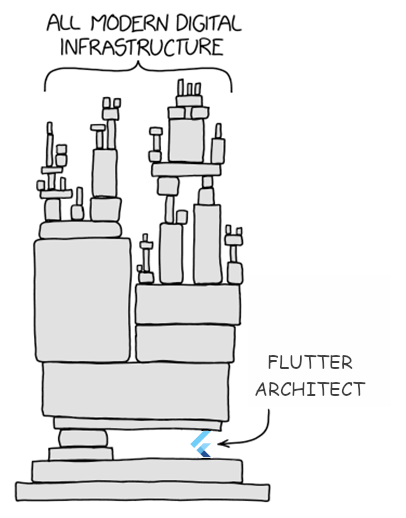Scalability in Flutter Projects
Plan for the Long Term!
📅 2023.09.20 - 👤 Borbély Viktor
 Image of a common codebase
Image of a common codebase
Building successful digital products is not just about current results, but also thinking about the future. A scalable and well-maintainable solution not only results in significant cost savings for the company in the long run, but also increases developer motivation and satisfaction. Interestingly, when a developer takes over a project and finds it well-structured, they are less tempted by the thought of rewriting the code. In this post, I show what technical aspects are worth paying attention to.
What makes a project scalable?
In today’s post, we seek answers to these questions: scalability and how to smartly manage dependencies? Why is all this
important not only for developers but also for executives? We’ll touch on the nuances of the pubspec.yaml file, the
advantages and pitfalls of monorepo, and examine how custom packages can help.
By scalability, we mean the system’s ability to function properly under increased load. Not only user growth can cause load, but also a company’s business growth.
A scalable mobile app is flexible and allows easy code maintenance and development.
Why is this important?
Because scalable systems are cost-effective and save time in the future. Not just for developers, but for the entire company.
A scalable system not only saves costs and time but also increases the development team’s motivation.
When a team works on a well-organized, scalable codebase, the frequency of code reviews and the need for refactoring also decrease. As a result, developers can spend more time on real problem-solving and innovation, which usually results in higher work morale and better productivity.
Dependency Management: the basics of pubspec.yaml
The pubspec.yaml is the soul of a Flutter project. Not just a simple configuration file, but your application’s ’ central controller’. Here you can define dependencies, that is, code packages and libraries needed for the application to function.
This makes the entire team’s work easier and everything needed for the app’s operation is gathered in one place.
It also provides an opportunity to reuse the Open Source community’s solutions. This saves time and resources. Dependency management is thus crucial for scalability and development time optimization.
The advantages and challenges of monorepo
The monorepo, that is, a project structure organized into a single repository, holds both advantages and challenges. The monorepo itself is not a special Git repository, but the way the content within it is organized makes it so.
Its advantages include unified version control, easier management of common dependencies, and facilitating teamwork. In such a system, changes are easier to track and dependencies within the project are simpler to manage.
However, the monorepo also has challenges: without proper infrastructure and tools, it can easily become unmanageable. Dependency management is particularly important here, as a poorly managed monorepo can quickly become chaotic.
The monorepo can become chaotic if there isn’t well-organized dependency management and version tracking. If multiple projects or modules depend on each other and their relationship isn’t properly managed, the codebase can easily become unstable.
In the case of a large team, individual members’ changes can easily “collide,” generating errors and unnecessary work. Therefore, code quality control, such as code review and testing, is critically important for a monorepo.
Custom Packages: tools for maintainability and scalability
Creating custom packages helps modularize the application. This enables code reuse and collaboration between development teams. Custom packages are also good because they allow isolated development and testing of parts of the application. As a result, the code becomes more maintainable and easily scalable.
Even better if these packages can be shared with the Open Source community, which generates further recognition and feedback. Not to mention the “free” fixes.
Domain-based organization is most common. This allows teams to focus on separate areas of responsibility. This not only reduces development time but also improves code quality, as each team can develop deeper expertise in its own domain.
This concept fits perfectly with microservices-like architectures and larger, complex systems.
In modularization, the application is usually organized into packages based on the following aspects:
- Security Module: Authentication, encryption, and permission management.
- Network Communication: API calls, WebSocket communication.
- Domain Logic: Business logic, data models, and data manipulation methods.
- UI/UX Components: Reusable widgets, styles, responsive design.
- Data Storage: Local database management, cache.
- Common Functionality: Navigation, state management.
- Payment Solutions: Transactions, online purchases, and related security measures.
The main goal here is to group closely related functions and separate them. These can be managed in different development phases or by teams. This makes maintenance and scaling easier.
Summary
Scalability brings not only technical but also business benefits.
A well-scalable system reduces development and maintenance costs, increases the development team’s motivation, and ensures future flexibility. Monorepo structure and modularized codebase can help with this.
The central package manager (pubspec.yaml file) allows easy integration of already existing, proven solutions, saving time and resources.
Overall, scalability is crucial not only for developers but also for executives.
Flutter’s toolkit is extremely versatile and efficient, making it an excellent choice for developing scalable and maintainable applications.
You might be interested in my other writings: